[Updated on February 16, 2023] The state of Georgia is filled with a variety of natural habitats, ranging from fertile Piedmont and hardwood forest to coastal beaches and the rolling hills of the North Georgia mountains.
Soaring above it all, there are more than 300 different species of birds in Georgia!
Some of these fascinating flyers find the state suitable all year round, while others visit the state during their migratory travels.
Each of these Georgia birds are beautiful in their own right, as they all have unique features and behaviors that make them endlessly entertaining to watch.
Our list of the 25 most beautiful birds of Georgia features some key identifying information about each one.
Some birds (like the Northern Cardinal and Eastern Bluebird) are commonly found in yards and public bird feeders, while others (such as the Barn Owl and Pileated Woodpecker) can be a bit more elusive.
Hopefully this list can help you learn more about your favorite backyard birds in Georgia, as well as species you might encounter while traveling through the Blue Ridge Mountains!
READ MORE: The Top 20 Things to Do in the Blue Ridge Mountains of Georgia
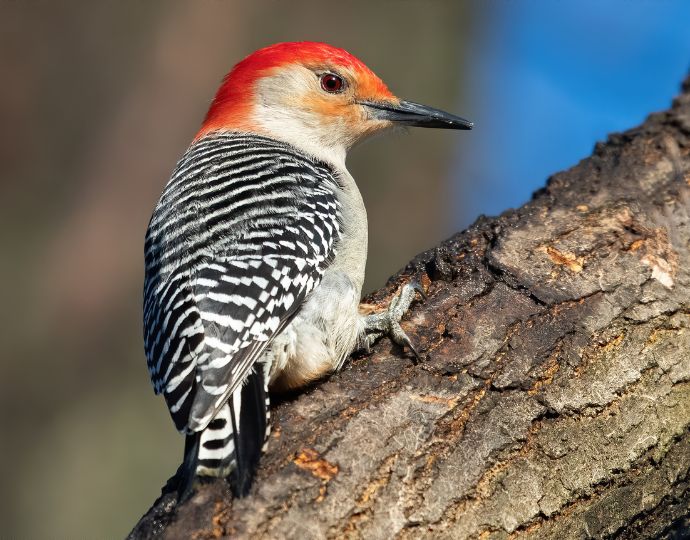
Birds of Georgia Guide
- Downy Woodpecker (Picoides pubescens)
- Pileated Woodpecker (Dryocopus pileatus)
- Red-headed Woodpecker (Melanerpes erythrocephalus)
- American Goldfinch (Spinus tristis)
- Blue Jay (Cyanocitta cristata)
- Brown Thrasher (Toxostoma rufum)
- Eastern Bluebird (Sialia sialis)
- House Finch (Carpodacus mexicanus)
- Northern Cardinal (Cardinalis cardinalis)
- Ruby-Throated Hummingbird (Archilochus colubris)
- Rufous Hummingbird (Selasphorus rufus)
- Barn Owl (Tyto alba)
- Barred Owl (Strix varia)
- Eastern Screech Owl (Megascops asio)
- Great Horned Owl (Bubo virginianus)
- Bald Eagle (Haliaeetus leucocephalus)
- Cooper’s Hawk (Accipiter cooperii)
- Osprey (Pandion haliaetus)
- Peregrine Falcon (Falco peregrinus)
- Red-tailed Hawk (Buteo jamaicensis)
- Mallard (Anas platyrhynchos)
- Ring-necked Duck (Aythya collaris)
- Wood Duck (Aix sponsa)
- Belted Kingfisher (Megaceryle alcyon)
- Great Blue Heron (Ardea herodias)
Woodpeckers in Georgia
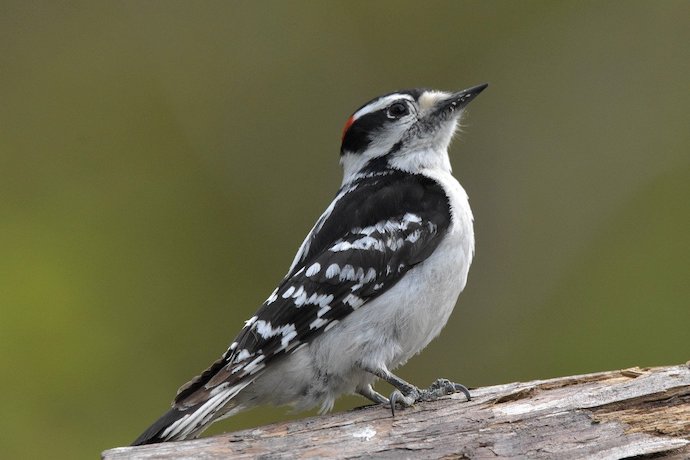
1. Downy Woodpecker
Picoides pubescens
If you’ve spotted a smaller woodpecker at your bird feeder, chances are it’s a Downy Woodpecker.
While they can be found in open woodlands, they are also commonly spotted in Georgia State Parks, orchards, and backyards.
These are the the smallest woodpeckers in Georgia (and North America), averaging from 5.5 inches to just under 7 inches long.
Their bill tends to be slightly smaller than other woodpeckers, but they have a similar body shape, with a blocky head, wide shoulders, and a straight back.
Insects (especially beetles and ants) are the Downy Woodpecker’s favorite meals, but they will also eat seeds, grains, acorns, and berries.
Strangely enough, they’ve even been known to drink from hummingbird feeders!
READ MORE: The 10 Best State Parks With Cabins In Georgia
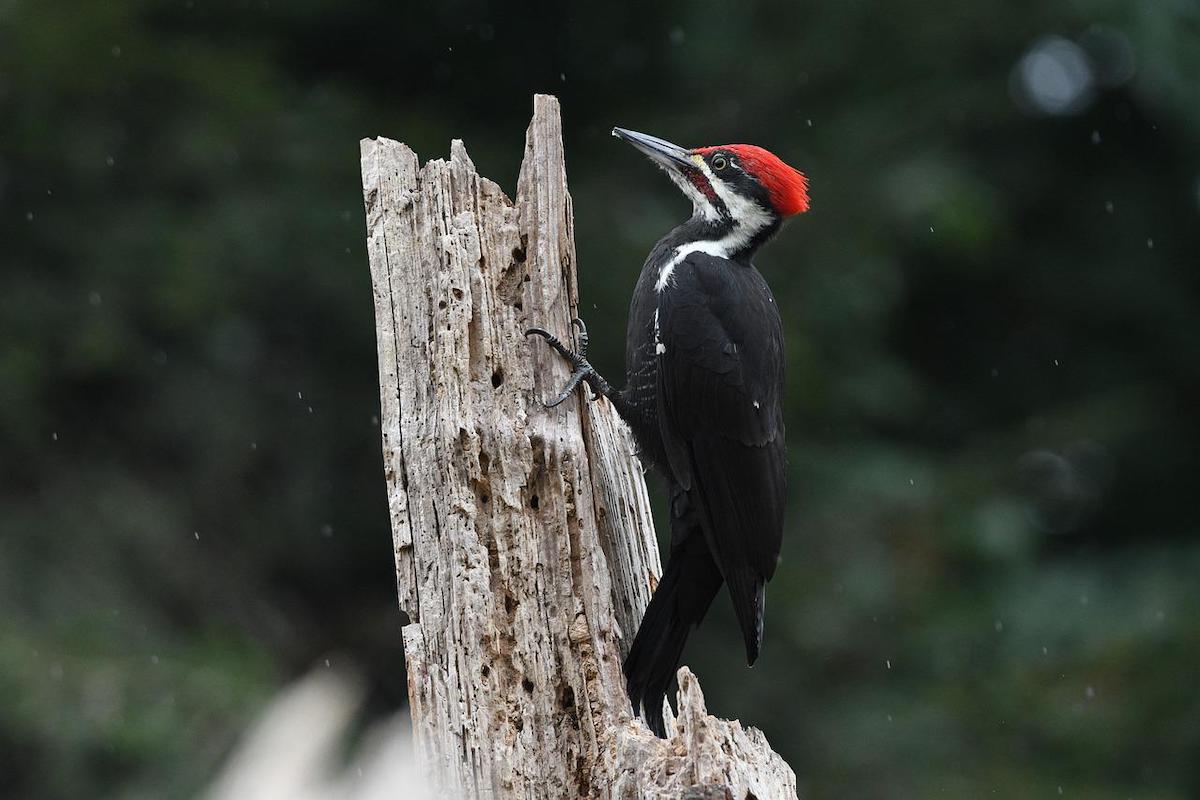
2. Pileated Woodpecker
Dryocopus pileatus
Pileated Woodpeckers are the largest woodpeckers in Georgia, and one of the biggest forest birds in North America.
They can grow up to 19 inches tall, with a wingspan that can reach up to 29.5 inches.
Like the Red-headed Woodpecker, they have red feathers on their head. But they also have distinguishing red and white markings on their faces, and black bodies with white underwing patches.
Pileated Woodpeckers reside in Georgia all year round in hardwood forests and drowned forests (where there are plenty of dead trees).
If you see rectangular holes in dead trees, it’s a surefire sign that a Pileated Woodpecker is (or was) near. They leave these unique holes after digging into rotten wood to find carpenter ants, which is their favorite snack.
READ MORE: The 20 Best Hiking Trails in the Chattahoochee National Forest

3. Red-headed Woodpecker
Melanerpes erythrocephalus
Easily identified by its solid-colored red head, the aptly named Red-headed Woodpecker is a medium-sized bird with a short tail and strong bill.
Their red, black, and white color pattern is so distinctive that it has garnered them nicknames like the “flag bird” and the “flying checker-board.”
Red-headed Woodpeckers can be found in Georgia all year in open woodland, pine Savannahs, or farms.
In typical woodpecker fashion, they will hammer at wood to find insects to eat. But they’re also known to catch insects in flight or on the ground.
They may even be spotted eating some fruits and small seeds.
READ MORE: The 30 Best Hiking Trails in North Georgia Bucket List
Common Birds in Georgia
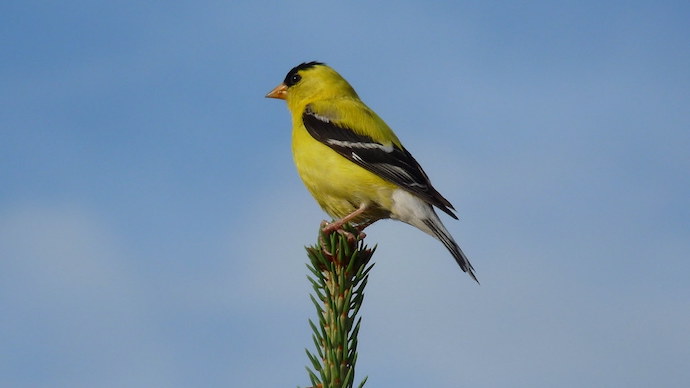
4. American Goldfinch
Spinus tristis
One of the more common backyard birds of Atlanta, the American Goldfinch is a small finch species reaching an average length of just 4-5 inches.
Adult males are easily recognized by their bright yellow coloring in spring and early summer, while adult females are generally a more dull yellow color.
These fast, acrobatic flyers can be heard calling during flight, and are often found at feeders in groups.
The natural Goldfinch habitat is fields with an abundance of weeds, floodplains, and cultivated areas. But they can often be found at feeders for backyard birds in the South throughout the year.
Also keep an eye on your feeder during the winter, because they tend to mill about abundantly during that time!
READ MORE: The 20 Best Places to Celebrate Christmas in Atlanta

5. Blue Jay
Cyanocitta cristata
With their captivating blue wings and tail feathers, bold black markings, and bright white bellies, Blue Jays stand out among the beautiful blue birds of Georgia.
They’re incredibly adaptable and will feed on everything from nuts, seeds, and grains to small wildlife, including frogs, rodents, and other birds!
Blue Jays are also known for their intelligence and will frequently mimic the call of the Red-shouldered hawk.
If you’re looking to Blue Jays in GA, they’re common throughout the year and reside along forest edges and in parks, groves, and woodlots.
While their bright color might lead you to believe they’re easy to find, Blue Jays can actually be quite inconspicuous as they fly covertly through the trees.
READ MORE: 52 Best Georgia Hiking Trails for the 52 Hikes Challenge

6. Eastern Bluebird
Sialia sialis
Looking like something straight out of Snow White, Eastern Bluebirds are among some of the most delightful small birds in Georgia.
Their bluish coloring is incredibly vibrant in the males, with the females sporting a more subdued shade of the color. Both have rusty-colored chests with white accents.
A year-round resident of Georgia, Eastern Bluebirds live in open country with scattered trees, farms, and other kinds of semi-open habitats (such as open pine woods and even suburbs).
In the past, these beautiful birds’ population was declining due to habitat loss and the loss of nesting sites.
Recent decades have shown an increase in their population, in large part thanks to backyard birdhouses!
READ MORE: The Top 25 Blue Ridge Mountain Towns in GA & NC

7. Brown Thrasher
Toxostoma rufum
No list of Georgia birds would be complete without including the state bird of Georgia, the Brown Thrasher.
Brown Thrashers can be found throughout the Appalachian range, heading north into Canada and west towards the Rockies. They migrate north in the summer, but spend much of the winter in the Southeastern US.
While they can be tricky to spot since they tend to hang out among shrubbery, thickets, and brush, once you spot them you’re sure to take note of their beauty.
They are a foxy brown and have a whitish underside, with dark streaking. Another impressive attribute of Georgia’s state bird is their unique singing ability.
Brown Thrashers can sing over 1,100 different song types, including imitations of birds such as Wood Thrushes and Northern Flickers.
READ MORE: The 15 Best Day Hikes on the Appalachian Trail in Georgia

8. House Finch
Carpodacus mexicanus
One of the more recent transplants to the Southeast, the House Finch has made its way from the west coast of the United States to settle in many east coast states, including Georgia.
These small birds reach an average of 5 inches long, and the adult males are known for their bright red faces and upper belly.
Interestingly enough, this rosy coloring is largely due to the diet that the birds prefer. The more yellow, orange, and red organic pigments are in their diet, the more red their feathers become.
If you’re looking at birds in Atlanta, it’s very likely you’ll see a House Finch, because they frequent towns and often mingle at bird feeders in the Metro Atlanta area.
READ MORE: The 20 Best Places to Visit in Georgia

9. Northern Cardinal
Cardinalis cardinalis
The Northern Cardinal is an incredibly popular bird known for its eye-catching red color.
But it’s only the males that sport that vibrant red shade of feathers.
Female Cardinals are far less flashy, sporting neutral-colored feathers with dashes of red along the tops of their heads and the base of their tails.
Northern Cardinals inhabit all states east of the Rockies, and can be spotted during any season at woodland edges, in thickets, gardens, and towns.
They feed on seeds, insects, grasses, flowers, and berries, and are very common visitors to backyard bird feeders.
To heighten your chances of attracting them, try putting out sunflower seeds.
READ MORE: The 15 Best Treehouse Rentals in the Georgia Mountains
Hummingbirds in Georgia
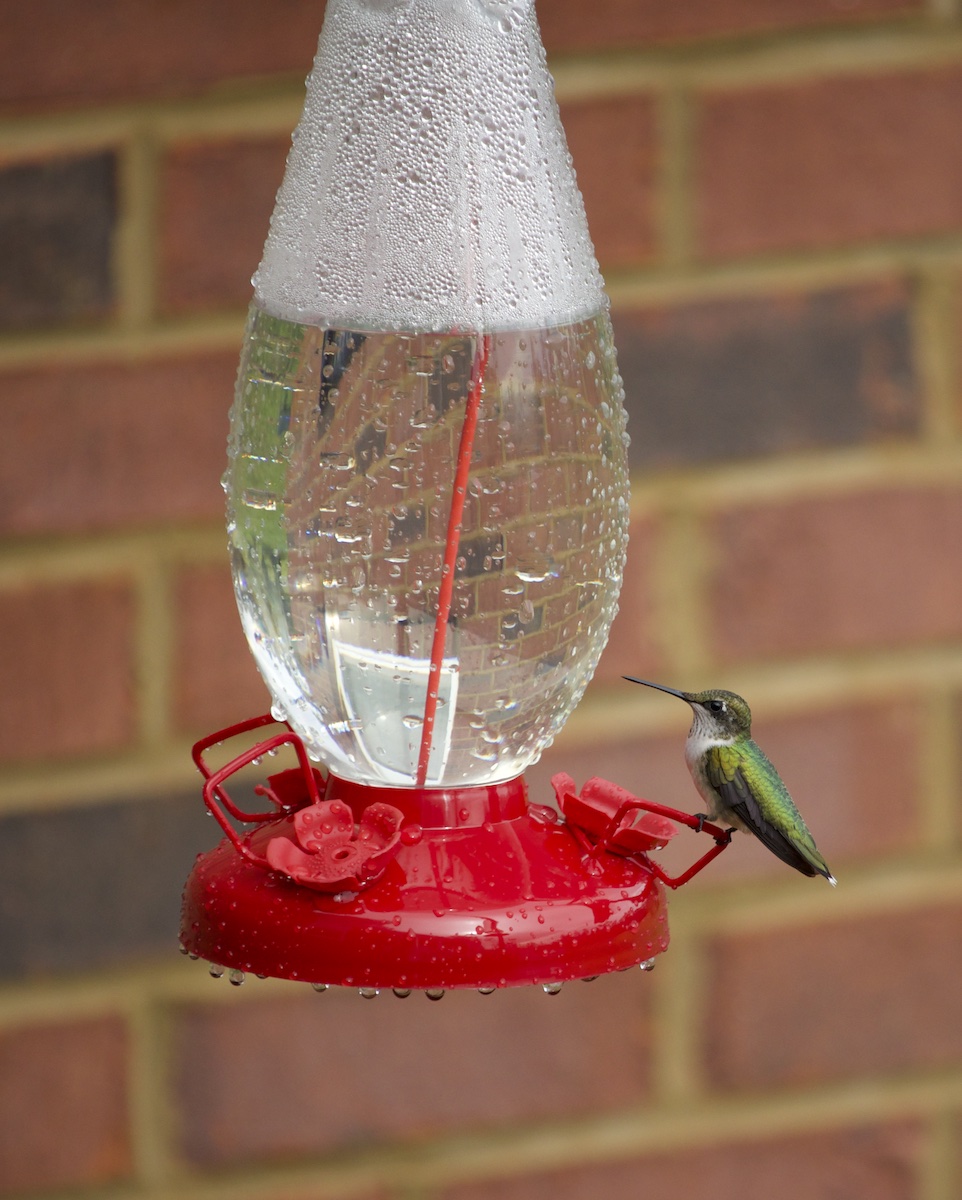
10. Ruby-Throated Hummingbird
Archilochus colubris
Ruby-throated Hummingbirds are the only species of hummingbirds that nest in Georgia. So they’re also the most common hummingbirds in Georgia.
These dazzling birds show up in a quick flash of green, with wings that can beat around 53 times a second.
They can reside in Georgia all year round. But, as a migratory species, many will arrive in late February or early March and leave before the fall colors peak in late October.
Red and orange flowers attract them naturally, but they will easily be swayed towards a hummingbird feeder if you put out the right mixture.
To make your own hummingbird nectar, mix 1 part sugar with 4 parts water until the sugar is dissolved. Please do not add red food coloring, as it is not good for the birds.
READ MORE: The 20 Best Places to Live in the Georgia Mountains
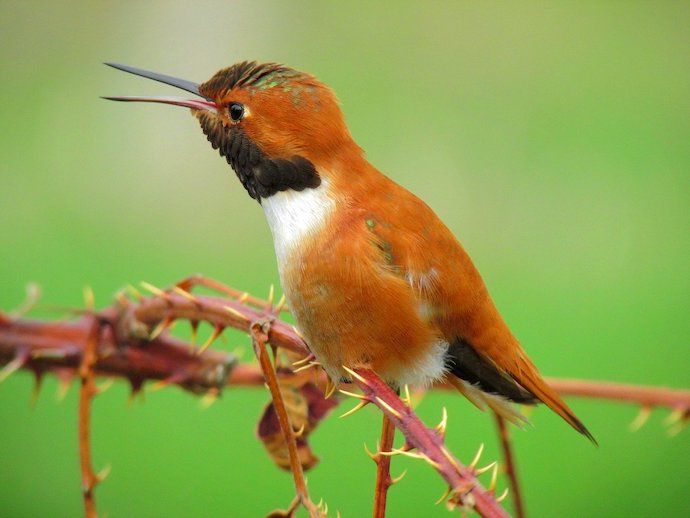
11. Rufous Hummingbird
Selasphorus rufus
Although it is a fairly common hummingbird in Georgia during the Winter, the Rufous Hummingbird is still a relatively rare sight in the state.
If you do spot one, it won’t be a bird you’ll soon forget, as it zips by flaunting its brilliant orange shades.
Despite their size, these are feisty birds and will charge hummingbirds double their weight at flowers and feeders.
They also have an incredible memory for location, which helps them find flowers to feed on each year.
Some Rufous Hummingbirds have even been spotted buzzing around places where a feeder had been the previous year in hopes of finding nectar, even though the feeder had been removed.
READ MORE: The Best North Georgia Christmas Events
Owls in Georgia
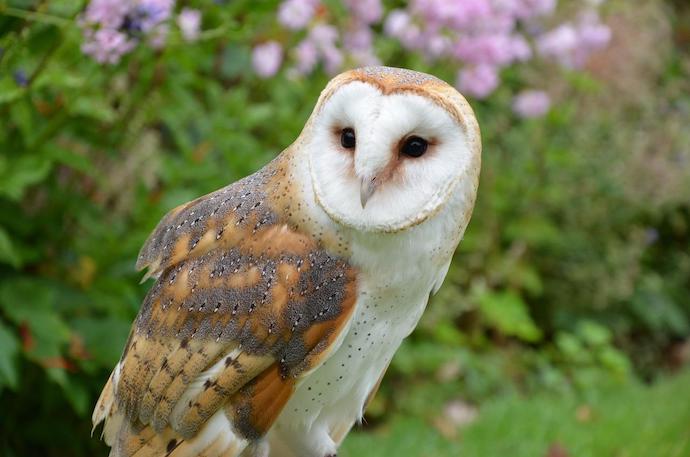
12. Barn Owl
Tyto alba
Given the fact that they often fly around at night, alerting you of their presence with an eerie shriek, it’s no wonder Barn Owls are the subject of folklore and superstition.
These spooky nocturnal birds often roost in places like church belfries, farms, and barns during the bright hours of the day before becoming active at night.
A Barn Owl’s diet mostly consists of rodents, but will also be supplemented with lizards and insects.
Their hearing and vision are so accurate in low light levels, they can strike their prey in complete darkness!
Barn Owls are also one of the most widespread land birds, as they live on six continents and several islands. You can find Barn Owls in Georgia all year round.
READ MORE: The 20 Best Fall Fairs and Festivals in Georgia
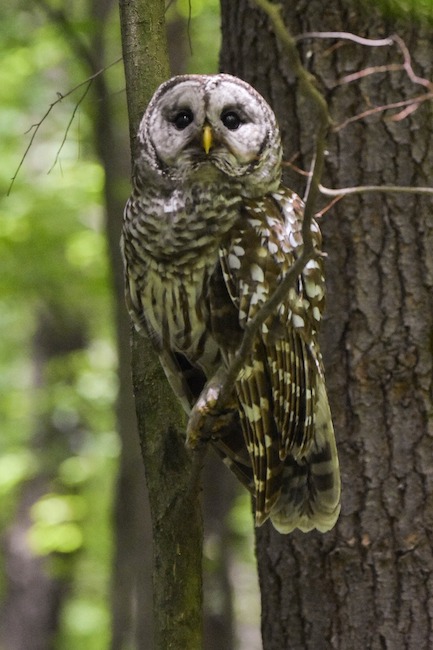
13. Barred Owl
Strix varia
Barred Owls are relatively large, stocky birds named for the horizontal stripes of light and dark brown running down their wings, back, and tail.
They are slightly smaller than the Great Horned Owl, and far less aggressive.
While they typically live in the same areas, Barred Owls will move somewhere else if there’s a Great Horned Owl nearby.
These two owl species can often be mistaken for one another, but Barred Owls have a very distinctive call– a loud “hoo, hoo, hoo-hoo.”
Barred Owls are also very inquisitive, and will often watch people as they walk by. If they do fly away, you can usually spot them a couple of trees away, continuing their investigation.
READ MORE: The 25 Best North Georgia Waterfalls (& How to Get to Them)
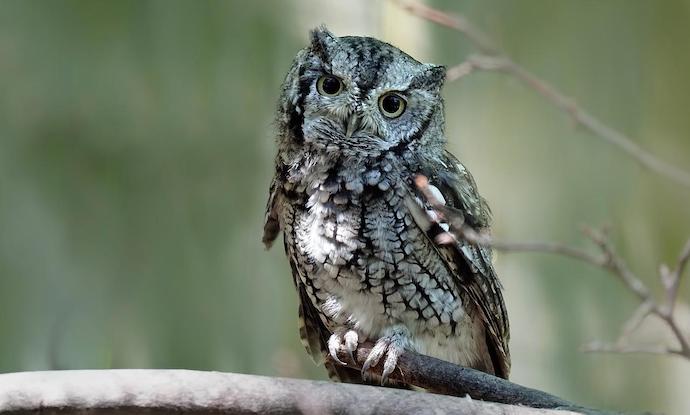
14. Eastern Screech Owl
Megascops asio
Of all the species of owls in Georgia, the Eastern Screech Owl is the most common.
They can live in rural areas where there are open woodlands, or suburban backyards with plenty of mature trees.
During the day, these owls roost in holes or dense cover before coming alive at dusk.
That’s when they hunt for large insects and small rodents by watching from a perch, then plunging down to scoop their prey from the ground.
Despite their name, these nightbirds don’t really screech, but rather sing out in whinnies and soft trills. Still, the sound can be a bit spooky in the dark.
Surprisingly, these beautiful birds are relatively small for owls, measuring around 6 to 9 inches long.
READ MORE: 101+ Fun Things to Do in North Georgia
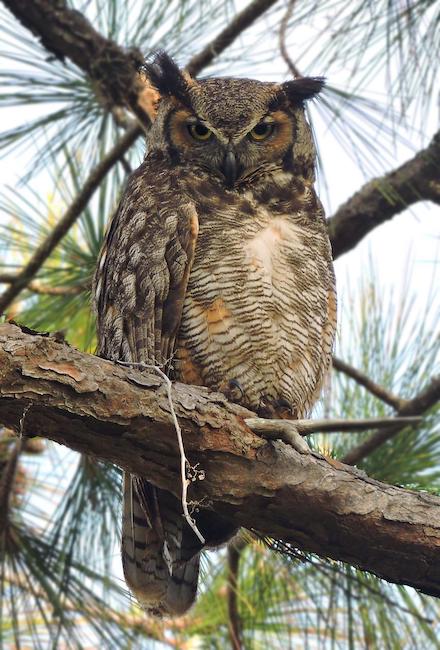
15. Great Horned Owl
Bubo Virginianus
When you picture an owl in your mind’s eye, it probably looks something like the Great Horned Owl.
They have that quintessential look, with a stocky body, piercing yellow eyes, and large tufts of feathers on their head that look like horns.
These striking owls can be found throughout North America. They live in Georgia all year round in a variety of habitats, including swamps, forests, open country, and along creeks and streams.
They are extremely skillful and aggressive hunters, searching for their prey mostly at night while perched in the trees.
They can hunt during the night thanks to their great hearing and ability to see well in low light conditions.
Great Horned Owls primarily prey on mammals, but they also enjoy eating snakes, lizards, frogs, birds, and insects.
READ MORE: The 25 Best Easy Hiking Trails to Waterfalls in Georgia
Birds of Prey in Georgia
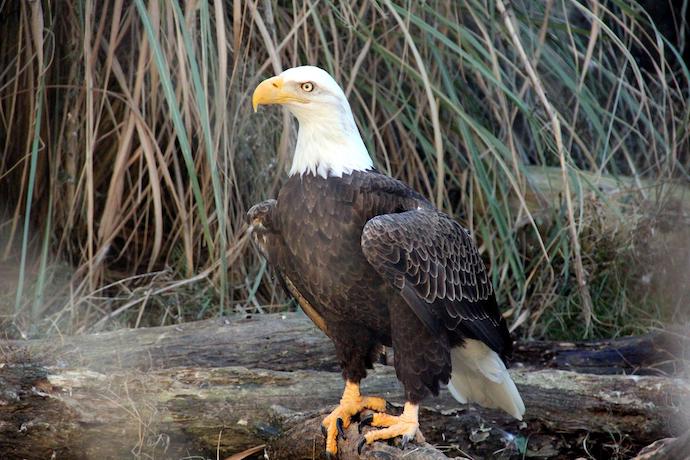
16. Bald Eagle
Haliaeetus leucocephalus
The most recognizable bird in the nation, the Bald Eagle has been the United States’ national symbol since 1782. These beautiful birds of prey are also considered sacred in Cherokee culture.
But by the mid-20th century they were so endangered, Congress passed the the Bald Eagle Protection Act to protect them. Thanks to conservation efforts, they were finally removed from the Endangered Species list in 2017.
These majestic birds aren’t actually bald, but have a white-feathered head in stark contrast to their dark brown bodies.
They often feed on carrion, such as dead fish that wash up on the shore, and will even steal food from smaller birds like Osprey. But despite their thieving tendencies, they are strong predators.
Your best chance at seeing one of these magnificent birds is to search around large bodies of water, including lakes, swamps, and wide rivers.
READ MORE: The 10 Best Kayaking Rivers in Georgia
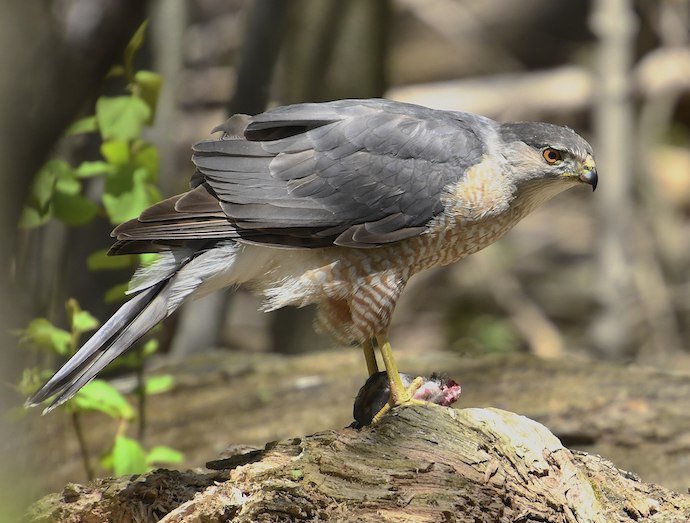
17. Cooper’s Hawk
Accipiter cooperii
Cooper’s Hawks are most prevalent in Georgia in the winter, when they’re typically seen at the edges of forests.
These are medium-sized hawks (about the same size as a crow), with a blue-gray back and white and tan underbelly.
Incredibly skillful fliers, Cooper’s Hawks hunt by stealth, using dense cover to camouflage them as they move from perch to perch in search of their next meal.
When they’re ready, they’ll burst through the canopy at high speeds to overtake their prey (mostly small birds and mammals).
At other times they’ll fly lower to the ground and grab their prey from behind shrubbery in a surprise attack!
READ MORE: The Best Christmas Lights in Atlanta and North Georgia

18. Osprey
Pandion haliaetus
Commonly found along coastlines and at lakes and rivers, Ospreys are a fish-hawk whose diet is composed almost entirely of fish.
They’ll fly over the water and hover in mid-air for just a moment once a fish is spotted before diving down to snatch them out of the water their sharp talons.
After they’ve captured their prey, they’ll rise from the water and soar away, often to feast in the trees.
They grasp slippery fish with their reversible outer toes (which is unusual for a hawk) and barbed pads on the soles of their feet.
Other unique features of the Osprey include a marked sort of kink in their wings that creates an M-shape when they fly.
READ MORE: The 20 Best Lakes in the North Georgia Mountains
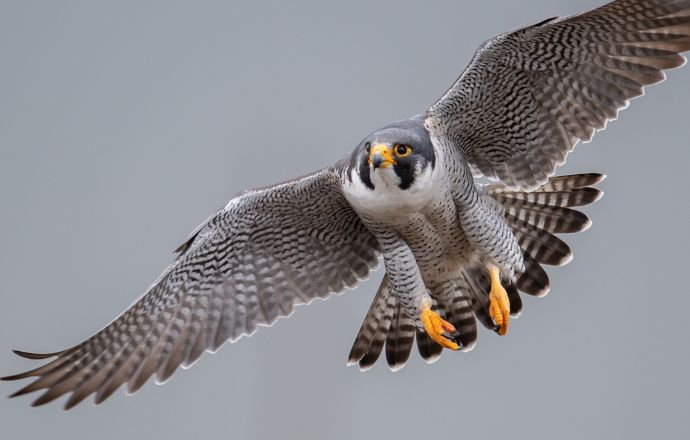
19. Peregrine Falcon
Falco peregrinus
The largest Falcon across most of the US, the Peregrine Falcon has a wingspan of up to 4.5 feet and stands about 1.5 feet tall.
Their main food source is smaller birds, such as pigeons, shorebirds, and ducks.
Similarly to most birds of prey, female Peregrine Falcons are generally larger than their male counterparts, making it easier for them to take on bigger prey.
Their bright yellow legs and beak are very distinct, as are the long tail and pointed wings, which are quite striking when they’re flying overhead.
They will often nest on top of tall structures, such as skyscrapers, water towers, or mountain cliffs to get the best view of their surroundings and so they can keep an eye out for food.
READ MORE: The 20 Best Hiking Trails In Atlanta GA (& Hikes Near Atlanta)
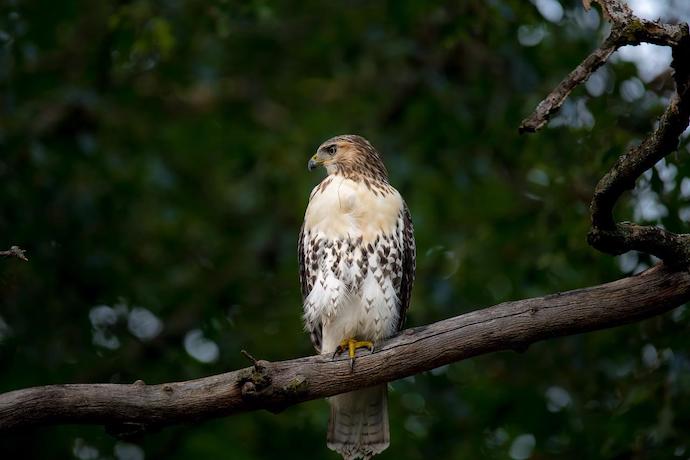
20. Red-tailed Hawk
Buteo jamaicensis
Once prized by the Cherokee people for their feathers, Red-tailed Hawks are widespread in North America as well as being the most commonly seen hawks in Georgia.
While their red tail is their distinguishing trait, the rest of their body can vary slightly in color from a deeper brownish-black to pale shades of tan.
However, they all share the same relative size, standing at about two feet tall, with a wingspan of around four feet.
These hawks have a varied diet that includes small mammals, birds, and reptiles, but it will vary based on their location and season.
After watching from a high perch and locating potential prey, these hawks will swoop down and capture the creature with their sharp talons.
READ MORE: Non-Venomous vs Venomous Snakes In Georgia (Identification Guide)
Ducks in Georgia
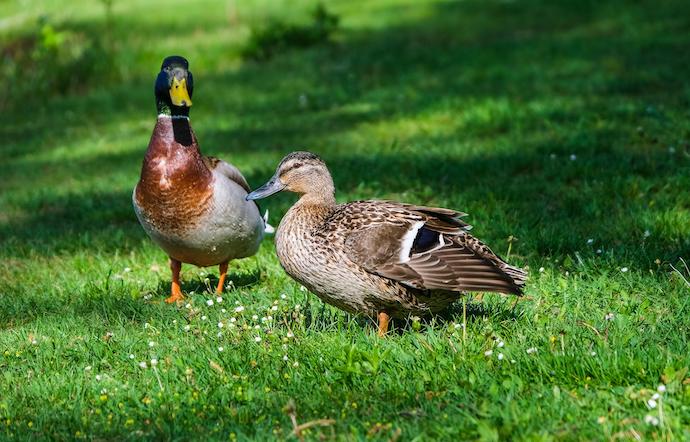
21. Mallard
Anas platyrhynchos
Mallards are abundant throughout the northern hemisphere, and they nest and live in Georgia year-round.
Males have an easily identifiable bright green head, with grey-brown flanks and a black tail. Females lack the males’ flashy-colored heads, and are instead brown, black, and tan all over.
Mallards are the ancestor of almost all domestic duck breeds, and in many places they have become domesticated to some degree.
They will readily accept handouts from people, but it’s generally considered a bad idea to feed ducks bread.
When they have to search for their own food, they forage in the water by submerging their heads. They’ll also graze on land, plucking seeds and grubbing for roots.
READ MORE: Lake Blue Ridge Boat Rentals, Cabin Rentals, Camping & Fishing
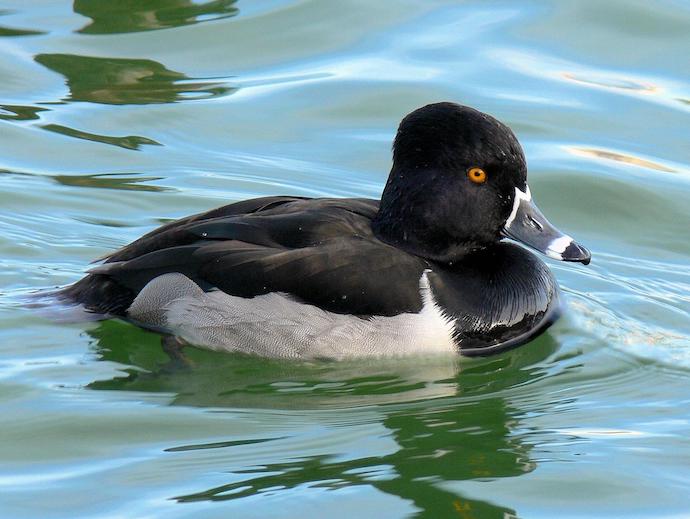
22. Ring-necked Duck
Aythya collaris
Ring-necked Ducks are another one of the ducks in Georgia that have different color schemes for males and females.
Males are a shiny black with white and grey accents, while females are a chocolate brown with a lightly patterned face. Despite their names, the ring on their necks is hardly ever visible.
Ring-necked Ducks are commonly found in small flocks or pairs, diving down to feed on invertebrates, mollusks, and other aquatic plants.
However, during migration and Winter, they may gather in flocks that number into the thousands!
While these are diving ducks, they generally like smaller bodies of water and shallow wetlands, such as ponds, bays, and swamps.
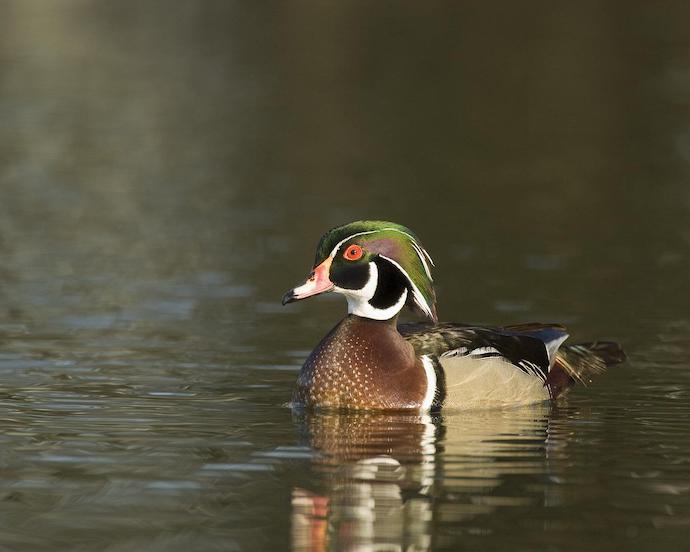
23. Wood Duck
Aix sponsa
The Wood Duck is one of the most beautiful and unique ducks in Georgia. It’s also the most common, and is the only duck that breeds in significant numbers here.
Wood Ducks have a chestnut-colored chest and iridescent green head contrasted with white stripes. They have a long body with a thick tail, short wings, thin neck, and boxy head.
Unlike most waterfowl, their unique shape makes them more comfortable flying through the woods and nesting in trees.
They feed mostly on aquatic plants and seeds, as well as some crustaceans.
They do this by either taking food directly from the surface of the water, or submerging their head and neck in search of a meal. Occasionally they will also look for insects on land.
READ MORE: The 10 Best Places for River Tubing in North Georgia
Water Birds of Georgia
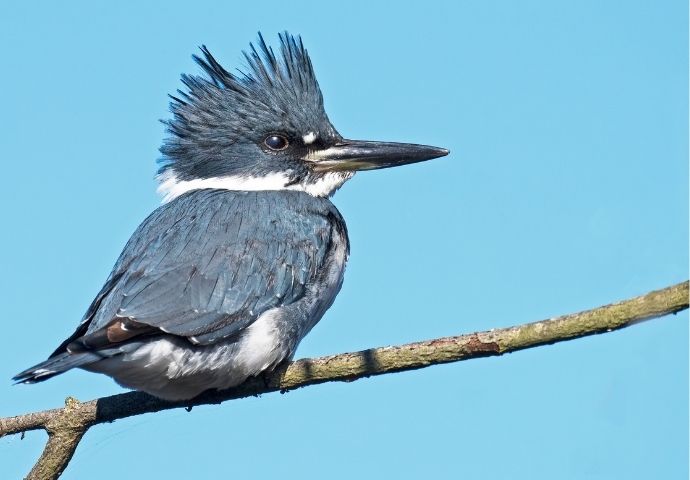
24. Belted Kingfisher
Megaceryle alcyon
Found in Georgia all year round, the Belted Kingfisher is a medium sized, top-heavy bird that frequents shorelines and rivers due to its diet of fish.
The average Belted Kingfisher measures about a foot long, and is comparable to the size of a Robin.
Female Kingfishers have a small brown band along their chest, while the male has a bare white chest.
They generally nest in burrows close to streams and rivers so that their food supply is never far from them.
To catch their food, Kingfishers will usually either plunge straight into the water from their perch or hover over the water and dive down.
READ MORE: The Best Places to Go White Water Rafting in GA

25. Great Blue Heron
Ardea herodias
One of the more recognizable birds found in Georgia, the Great Blue Heron has a wingspan of up to 6.5 feet and stands up to 4 feet tall.
Their name comes from the blue-gray coloring that their feathers have, and they will often have a black stripe over their eyes.
These beautiful birds live on a diet of fish and other aquatic life, so they frequent lakes, rivers and coastal areas.
They typically move very slowly on their stilt-like legs, and can often be seen standing still as a statue so they don’t scare off any potential prey.
They’re fascinating to watch as they hunt and make an insane (almost dinosaur-like) squawk, so keep an eye out on your next lake trip! -by Christina Maggitas, lead image via Canva




